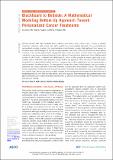Files in this item
Blackboard-to-bedside : a mathematical modeling bottom-up approach towards personalized cancer treatments
Item metadata
| dc.contributor.author | Hamis, Sara | |
| dc.contributor.author | Powathil, Gibin | |
| dc.contributor.author | Chaplain, Mark A. J. | |
| dc.date.accessioned | 2019-08-10T23:42:26Z | |
| dc.date.available | 2019-08-10T23:42:26Z | |
| dc.date.issued | 2019-02-11 | |
| dc.identifier | 255932802 | |
| dc.identifier | 0766f9fa-9920-408b-959e-0b6ed611916f | |
| dc.identifier | 85061386864 | |
| dc.identifier | 000461065200001 | |
| dc.identifier.citation | Hamis , S , Powathil , G & Chaplain , M A J 2019 , ' Blackboard-to-bedside : a mathematical modeling bottom-up approach towards personalized cancer treatments ' , JCO Clinical Cancer Informatics , vol. 2019 , no. 3 . https://doi.org/10.1200/CCI.18.00068 | en |
| dc.identifier.issn | 2473-4276 | |
| dc.identifier.uri | https://hdl.handle.net/10023/18289 | |
| dc.description.abstract | Cancers present with high variability across patients and tumors; thus, cancer care, in terms of disease prevention, detection, and control, can highly benefit from a personalized approach. For a comprehensive personalized oncology practice, this personalization should ideally consider data gathered from various information levels, which range from the macroscale population level down to the microscale tumor level, without omission of the central patient level. Appropriate data mined from each of these levels can significantly contribute in devising personalized treatment plans tailored to the individual patient and tumor. Mathematical models of solid tumors, combined with patient-specific tumor profiles, present a unique opportunity to personalize cancer treatments after detection using a bottom-up approach. Here, we discuss how information harvested from mathematical models and from corresponding in silico experiments can be implemented in preclinical and clinical applications. To conceptually illustrate the power of these models, one such model is presented, and various pertinent tumor and treatment scenarios are demonstrated in silico. The presented model, specifically a multiscale, hybrid cellular automaton, has been fully validated in vitro using multiple cell-line–specific data. We discuss various insights provided by this model and other models like it and their role in designing predictive tools that are both patient, and tumor specific. After refinement and parametrization with appropriate data, such in silico tools have the potential to be used in a clinical setting to aid in treatment protocols and decision making. | |
| dc.format.extent | 11 | |
| dc.format.extent | 1637038 | |
| dc.language.iso | eng | |
| dc.relation.ispartof | JCO Clinical Cancer Informatics | en |
| dc.subject | QA Mathematics | en |
| dc.subject | RC0254 Neoplasms. Tumors. Oncology (including Cancer) | en |
| dc.subject | T-NDAS | en |
| dc.subject | SDG 3 - Good Health and Well-being | en |
| dc.subject.lcc | QA | en |
| dc.subject.lcc | RC0254 | en |
| dc.title | Blackboard-to-bedside : a mathematical modeling bottom-up approach towards personalized cancer treatments | en |
| dc.type | Journal item | en |
| dc.contributor.institution | University of St Andrews. School of Mathematics and Statistics | en |
| dc.contributor.institution | University of St Andrews. Applied Mathematics | en |
| dc.identifier.doi | https://doi.org/10.1200/CCI.18.00068 | |
| dc.description.status | Peer reviewed | en |
| dc.date.embargoedUntil | 2019-08-11 |
This item appears in the following Collection(s)
Items in the St Andrews Research Repository are protected by copyright, with all rights reserved, unless otherwise indicated.

